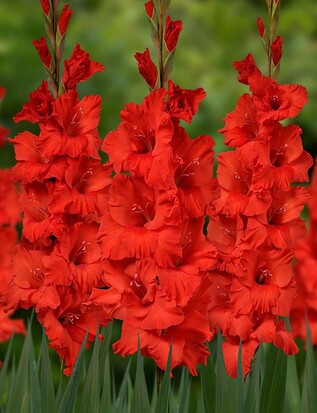|
Part of the iris family, a “glad” is often described as a flowering bulb, but the bulb is actually a “corm.” Each year the plant produces a new corm and discards the old one. In our zone 3 climate, the new corm is dug up in the fall, has its stem and leaves removed (all but an inch), then dried for 1-2 weeks in a warm place with good air circulation, and finally stored dry, indoors at about 50 degrees for planting next spring. Gladiolus should be grown in full sun, whether in a cutting garden, perennial garden, vegetable garden, raised bed or container. Be creative, put glads front and center, pair them with cannas, colocascia (elephant ears), caladiums, or coleus. Explore planting a variety of types, heights and flower color, form and size. The flowers generally begin opening 80-90 days after planting. To extend the bloom time, plant the first batch in spring after all danger of frost has passed, and plant additional corms every week or two until early summer. Before planting, prepare well-drained soil to a depth of 6 to 10”, adding compost and an all-purpose granular fertilizer. Plant “grandiflora” glads 6 to 8” deep to help keep their stems upright and “dwarf” glads at 4 to 6” deep, spacing both types 4 to 6” apart. After planting, applying 2 to 3” of mulch helps retain moisture and control weeds. Water regularly and deeply, at least an inch of water per week. When stressed by heat/drought, glads are susceptible to disease and thrips/spider mites that disfigure the flowers. Support glads from leaning or toppling from wind or rain by tying them to bamboo canes—or plant shorter, 2-foot glads. High-quality, larger corms will give you taller stems with more flowers. For the longest vase life, harvest glads when the bottom two flowers are fully open. The rest will gradually unfurl in the vase. If you experience difficulty with integrating taller glads in a tabletop arrangement, shorten the stems and remove a couple of the lower flowers or cut some of the top. Snap off spent flowers and recut the stem as needed. Credit to https://ngb.org/year-of-the-gladiolus/ Contributed by: Vicki Gee-Treft, Master Gardener Volunteer
0 Comments
Leave a Reply. |
|
| North Country MGV | gARDEN bLOGS |
Location |
|

 RSS Feed
RSS Feed